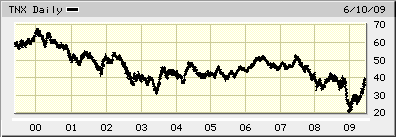Call me a skeptic when it comes to getting really nervous about rising interest rates. "All of this debt we are selling is really having a severe impact on interest rates," they say. It is true that interest rates on 10-year government bonds have doubled from 2% to 4% in recent months. However, not looking more than six or twelve months back does not give a very clear picture. Below is a decade-long chart of the yield on the benchmark 10-year treasury bond:
See why I am not buying the whole "higher interest rates will kill the economic recovery" argument? Yields between 4% and 6% were pretty common before the recession began and they existed with solid economic growth and less government debt. Even if yields rise further, to the 5%-6% range, it won't be the end of the world. In fact, it might actually be nice for consumers. We finally have a positive savings rate in the U.S. and it would be good to get bank certificates of deposit to yield 5% again so those dollars being saved could earn solid interest.
Of course, many will argue that if mortgage rates reach 6%-7% the housing market will never recover because people will no longer be able to afford to buy a house. Consider these numbers, though. The monthly payment on a $200,000 mortgage at 5.5% (today's rate) is $1,136, compared with $1,331 at a 7% mortgage rate. If you are earning ~$5,000 per month (about what you should make to buy a $200,000 house) another $200 per month (before the interest tax deduction, mind you) really should not be the difference between renting and buying for most people. Mortgage rates would have to go up a lot more to cripple the housing market, in my view.






